Pyritization and Preservation Model of Chrysophyte Cyst Fossils in Shales during the Triassic Carnian Pluvial Episode, Ordos Basin, China: Evidence from Cyclostratigraphy, Radiometric Dating and Geochemical Analyses
Abstract
1. Introduction
2. Geologic Setting
3. Materials and Methods
3.1. Natural Gamma Ray (GR) Logging and Cyclostratigraphic Analysis
3.2. SEM Observation and Energy-Dispersive Spectroscopy (EDS) Analysis
3.3. TOC and TS Analysis
3.4. Carbon, Nitrogen, and Sulfur Isotopic Analysis
3.5. Major and Trace Element Analysis
4. Results
4.1. Spectral Analysis and Floating Astronomical Scale
4.2. TOC and TS Contents
4.3. Inorganic Elements and Isotopic Results
5. Discussion
5.1. Pyritization of Chrysophyte Cyst Fossils
5.2. Age of the Chrysophyte Cysts and the Triassic CPE
5.3. Depositional Response and Redox Conditions in the CPE
5.4. Models of Preservation of Chrysophyte Cyst Fossils
6. Conclusions
Supplementary Materials
Author Contributions
Funding
Data Availability Statement
Acknowledgments
Conflicts of Interest
References
- Andersen, R.A. Synurophyceae classis nov., a new class of algae. Am. J. Bot. 1987, 74, 337–353. [Google Scholar]
- Pla, S.; Anderson, N.J. Environmental factors correlated with chrysophyte cyst assemblages in low arctic lakes of southwest Greenland. J. Phycol. 2005, 41, 957–974. [Google Scholar]
- Adam, D.P.; Mahood, A.D. Chrysophyte cysts as potential environmental indicators. GSA Bull. 1981, 92, 839–844. [Google Scholar]
- Holen, D.A. Chrysophyte stomatocyst production in laboratory culture and descriptions of seven cyst morphotypes. Phycologia 2014, 53, 426–432. [Google Scholar]
- Hernández–Almeida, I.; Grosjean, M.; Tylmann, W.; Bonk, A. Chrysophyte cyst–inferred variability of warm season lake water chemistry and climate in northern Poland: Training set and downcore reconstruction. J. Paleolimnol. 2015, 53, 123–138. [Google Scholar]
- Korkonen, S.; Weckström, J.; Korhola, A. Biogeography and ecology of freshwater chrysophyte cysts in Finland. Hydrobiologia 2020, 847, 487–499. [Google Scholar]
- Pla, S.; Catalan, J. Chrysophyte cysts from lake sediments reveal the submillennial winter/spring climate variability in the northwestern Mediterranean interval throughout the Holocene. Clim. Dyn. 2005, 24, 263–278. [Google Scholar]
- Zhang, W.Z.; Yang, H.; Xia, X.Y.; Xie, L.Q.; Xie, G.W. Triassic chrysophyte cyst fossils discovered in the Ordos Basin, China. Geology 2016, 44, 1031–1034. [Google Scholar]
- Wilkinson, A.N.; Hall, R.I.; Smol, J.P. Chrysophyte cysts as paleolimnological indicators of environmental change due to cottage development and acidic deposition in the Muskoka-Haliburton interval, Ontario, Canada. J. Paleolimnol. 1999, 22, 17–39. [Google Scholar]
- Pla, S.; Camarero, L.; Catalan, J. Chrysophyte cyst relationships to water chemistry in Pyrenean lakes (NE Spain) and their potential for environmental reconstruction. J. Paleolimnol. 2003, 30, 21–34. [Google Scholar]
- Zhao, G.C.; Sun, M.; Wilde, S.A.; Li, S.Z. Late Archean to Paleoproterozoic evolution of the North China Craton: Key issues revisited. Precambrian Res. 2005, 136, 177–202. [Google Scholar]
- Yang, H.; Deng, X. Deposition of Yanchang Formation deep-water sandstone under the control of tectonic events in the Ordos Basin. Petrol. Explor. Dev. 2013, 40, 549–557. [Google Scholar]
- Zou, C.; Wang, L.; Li, Y.; Tao, S.; Hou, L. Deep-lacustrine transformation of sandy debrites into turbidites, Upper Triassic, Central China. Sediment. Geol. 2012, 265, 143–155. [Google Scholar]
- Zhang, W.Z.; Yang, W.W.; Xie, L.Q. Controls on organic matter accumulation in the triassic Chang 7 lacustrine shale of the Ordos Basin, central China. Int. J. Coal Geol. 2017, 183, 38–51. [Google Scholar]
- Guo, H.; Jia, W.; Peng, P.A.; Lei, Y.; Luo, X.; Cheng, M.; Wang, X.; Zhang, L.; Jiang, C. The composition and its impact on the methane sorption of lacustrine shales from the Upper Triassic Yanchang Formation, Ordos Basin, China. Mar. Petrol. Geol. 2014, 57, 509–520. [Google Scholar]
- Liu, H.L.; Zou, C.N.; Qiu, Z.; Pan, S.Q.; Zhang, W.Z.; Jing, Z.H.; Hao, J.H.; Wu, S.T.; Li, S.X.; Guo, Q.L. Sedimentary enrichment factors of extraordinarily high organic matter in the sub-member 3 of Member 7 of Yanchang Formation, Ordos Basin. Acta Petrolei Sin. 2022, 43, 1520–1541. [Google Scholar]
- Zhang, W.Z.; Yang, H.; Yang, W.W.; Wu, K.; Liu, F. Assessment of geological characteristics of lacustrine shale oil reservoir in Chang7 Member of Yanchang Formation, Ordos Basin. Geochimica 2015, 44, 505–515. [Google Scholar]
- Yang, S.R.; Gang, W.Z.; Cao, J.J.; Liu, J.P.; Gao, G.; Dang, W.L. Geochemical characteristics, origin and carbon isotope reversal of the presalt natural gas in the Lower Paleozoic Ordovician carbonates, Ordos Basin, China. Mar. Petrol. Geol. 2022, 139, 105577. [Google Scholar]
- Chen, G.; Gang, W.Z.; Liu, Y.Z.; Wang, N.; Guo, Y.; Zhu, C.Z.; Cao, Q.Y. High-resolution sediment accumulation rate determined by cyclostratigraphy and its impact on the organic matter abundance of the hydrocarbon source rock in the Yanchang Formation, Ordos Basin, China. Mar. Petrol. Geol. 2019, 103, 1–11. [Google Scholar]
- Schnyder, J.; Ruffell, A.; Deconinck, J.F.; Baudin, F. Conjunctive use of spectral gamma–ray logs and clay mineralogy in defining late Jurassic–early Cretaceous palaeoclimate change (Dorset, U.K.). Palaeogeogr. Palaeocl. 2006, 229, 303–320. [Google Scholar]
- Li, M.S.; Hinnov, L.A.; Huang, C.J.; Ogg, J.G. Sedimentary noise and sea levels linked to land–ocean water exchange and obliquity forcing. Nat. Commun. 2018, 9, 1004. [Google Scholar] [CrossRef]
- Wu, H.C.; Zhang, S.L.; Huang, Q.H. Establishment of floating astronomical time scale for the terrestrial Late Cretaceous Qingshankou Formation in the Songliao Basin of Northeast China. Ear. Sci. Front. 2008, 15, 159–169. [Google Scholar] [CrossRef]
- Zhang, R.; Jin, Z.J.; Liu, Q.Y.; Li, P.; Huang, Z.K.; Shi, J.Y.; Ge, Y.J.; Du, K.F. Astronomical constraints on deposition of the Middle Triassic Chang 7 lacustrine shales in the Ordos Basin, Central China. Palaeogeogr. Palaeocl. 2019, 528, 87–98. [Google Scholar] [CrossRef]
- Yuan, W.; Liu, G.D.; Bulseco, A.; Zhou, X.X. Iron speciation in organic-rich shales from the Upper Triassic Yanchang Formation, Ordos Basin, Northern China: Implications for depositional environment. J. Asian Earth Sci. 2021, 220, 104917. [Google Scholar]
- Chen, G.; Chang, X.C.; Gang, W.Z.; Wang, N.; Zhang, P.F.; Cao, Q.Y.; Xu, J.B. Anomalous positive pyrite sulfur isotope in lacustrine black shale of the Yanchang Formation, Ordos Basin: Triggered by paleoredox chemistry changes. Mar. Petrol. Geol. 2020, 121, 104587. [Google Scholar] [CrossRef]
- Chen, R.Q.; Liu, G.D.; Shang, F.; Cao, Y.S. Nitrogen isotope compositions of the Upper Triassic Chang 7 Shale, Ordos Basin, North China: Implications for depositional redox conditions. Mar. Petrol. Geol. 2019, 109, 279–290. [Google Scholar] [CrossRef]
- Yang, S.R.; Gao, G.; Liu, Y.; Gang, W.Z.; Dang, W.L. Organic geochemistry and petrographic characteristics of the shales from the Late Miocene Zeit Formation in the Tokar area, Red Sea Basin: Implications for depositional environment and hydrocarbon potential. J. Petrol. Sci. Eng. 2020, 199, 107757. [Google Scholar] [CrossRef]
- Chen, R.Q.; Liu, G.D.; Shang, F.; Cao, Y.S. Variations in hydrocarbon generating potential of the Chang 7 shale: Evidence from pyrite morphology and sulfur isotope. J. Petrol. Sci. Eng. 2020, 195, 107747. [Google Scholar] [CrossRef]
- Li, X.; Gang, W.; Yao, J.; Gao, G.; Wang, C.; Li, J.; Liu, Y.; Guo, Y.; Yang, S. Major and trace elements as indicators for organic matter enrichment of marine carbonate rocks: A case study of Ordovician subsalt marine formations in the central-eastern Ordos Basin, North China. Mar. Petrol. Geol. 2020, 111, 461–475. [Google Scholar]
- Hu, Y.; Feng, D.; Peckmann, J.; Roberts, H.H.; Chen, D.F. New insights into cerium anomalies and mechanisms of trace metal enrichment in authigenic carbonate from hydrocarbon seeps. Chem. Geol. 2014, 381, 55–66. [Google Scholar] [CrossRef]
- Taylor, S.R. The Continental Crust: Its Composition and Evolution: An Examination of the Geochemical Record Preserved in Sedimentary Rocks; Blackwell Scientific Publications: Palo Alto, CA, USA, 1985; p. 328. [Google Scholar]
- Laskar, J.; Robutel, P.; Joutel, F.; Gastineau, M.; Correia, A.C.M.; Levrard, B. A long–term numerical solution for the insolation quantities of the Earth. Astron. Astrophys. 2004, 428, 261–285. [Google Scholar] [CrossRef]
- Sun, Y.W.; Li, X.; Liu, Q.Y.; Zhang, M.D.; Li, P.; Zhang, R.; Shi, X. In search of the inland Carnian Pluvial Event: Middle–Upper Triassic transition profile and U–Pb isotopic dating in the Yanchang Formation in Ordos Basin, China. Geol. J. 2019, 55, 4905–4919. [Google Scholar] [CrossRef]
- Zhu, R.K.; Cui, J.W.; Deng, S.H.; Luo, Z.; Lu, Y.Z.; Qiu, Z. High-precision Dating and Geological Significance of Chang 7 Tuff Zircon of the Triassic Yanchang Formation, Ordos Basin in Central China. Acta. Geol. Sin.-Engl. Ed. 2019, 93, 1823–1834. [Google Scholar] [CrossRef]
- Dal Corso, J.; Gianolla, P.; Rigo, M.; Franceschi, M.; Roghi, G.; Mietto, P.; Manfrin, S.; Raucsik, B.; Budai, T.; Jenkyns, H.C.; et al. Multiple negative carbon-isotope excursions during the Carnian Pluvial Episode (Late Triassic). Earth-Sci. Rev. 2018, 185, 732–750. [Google Scholar] [CrossRef]
- Lu, J.; Zhang, P.X.; Dal Corso, J.; Yang, M.F.; Wignall, P.B.; Greene, S.E.; Shao, L.Y.; Lyu, D.; Hilton, J. Volcanically driven lacustrine ecosystem changes during the Carnian Pluvial Episode (Late Triassic). Proc. Natl. Acad. Sci. USA. 2021, 118, e2109895118. [Google Scholar] [CrossRef]
- Raiswell, R.; Canfield, D.E. Sources of iron for pyrite formation in marine sediments. Am. J. Sci. 1998, 298, 219–245. [Google Scholar] [CrossRef]
- Wilkinson, A.N.; Zeeb, B.A.; Smol, J.P. Atlas of Chrysophycean Cysts Vol. II; Kluwer Academic Publishers: Dordrecht, The Netherlands, 2001; pp. 1–169. [Google Scholar]
- Pang, W.T. Studies on Chrysophycean Stomatocysts from the Wetlands in Great Xing’an Mountains, China; East China Normal University: Shanghai, China, 2012; pp. 23–28. [Google Scholar]
- Simms, M.J.; Ruffell, A.H. Synchroneity of climatic change and extinctions in the Late Triassic. Geology 1989, 17, 265–268. [Google Scholar] [CrossRef]
- Dal Corso, J.; Gianolla, P.; Newton, R.J.; Franceschi, M.; Roghi, G.; Caggiati, M.; Raucsik, B.; Budai, T.; Haas, J.; Preto, N. Carbon isotope records reveal synchronicity between carbon cycle perturbation and the “Carnian Pluvial Event” in the Tethys realm (Late Triassic). Glob. Planet. Change 2015, 127, 79–90. [Google Scholar] [CrossRef]
- Sun, Y.D.; Wignall, P.B.; Joachimski, M.M.; Bond, D.P.G.; Grasby, S.E.; Lai, X.L.; Wang, L.N.; Zhang, Z.T.; Sun, S. Climate warming, euxinia and carbon isotope perturbations during the Carnian (Triassic) crisis in South China. Earth Planet. Sci. Lett. 2006, 444, 88–100. [Google Scholar] [CrossRef]
- Boschetti, T.; Cortecchi, G.; Toscani, L.; Iacumin, P. Sulfur and oxygen isotope compositions of upper Triassic sulfates from northern Apennines (Italy): Palaeogeographic and hidrogeochemical implications. Geol. Acta 2011, 9, 129–147. [Google Scholar]
- Canfield, D.E. Biogeochemistry of sulfur isotopes. In Stable Isotope Geochemistry; Valley, J.W., Cole, D., Eds.; Mineralogical Society of America and Geochemical Society, Reviews of Mineralogy and Geochemistry: Washington, DC, USA, 2001; Volume 43, pp. 607–636. [Google Scholar]
- Quan, T.M.; Adigwe, E.N.; Riedinger, N.; Puckette, J. Evaluating nitrogen isotopes as proxies for depositional environmental conditions in shales: Comparing Caney and Woodford Shales in the Arkoma Basin, Oklahoma. Chem. Geol. 2013, 360–361, 231–240. [Google Scholar] [CrossRef]
- Talbot, M.R. Nitrogen isotopes in palaeolimnology. In Tracking Environmental Change Using Lake Sediments. Volume 2: Physical and Geochemical Methods; Last, W.M., Smol, J.P., Eds.; Kluwer Academic Publishers: Dordrecht, The Netherlands, 2001; pp. 401–439. [Google Scholar]
- Algeo, T.J.; Maynard, J.B. Trace–element behavior and redox facies in core shales of Upper Pennsylvanian Kansas–type cyclothems. Chem. Geol. 2004, 206, 289–318. [Google Scholar] [CrossRef]
- Tribovillard, N.; Algeo, T.J.; Lyons, T.; Riboulleau, A. Trace–metals as paleoredox and paleoproductivity proxies: An update. Chem. Geol. 2006, 232, 12–32. [Google Scholar] [CrossRef]
- Hatch, J.R.; Leventhal, J.S. Relationship between inferred redox potential of the depositional environment and geochemistry of the Upper Pennsylvanian (Missourian) Stark Shale Member of the Dennis Limestone, Wabaunsee County, Kansas, USA. Chem. Geol. 1992, 99, 65–82. [Google Scholar] [CrossRef]
- Jones, B.; Manning, D.A.C. Comparison of geochemical indices used for the interpretation of palaeoredox conditions in ancient mudstones. Chem. Geol. 1994, 111, 111–129. [Google Scholar] [CrossRef]
- Dal Corso, J.; Bernardi, M.; Sun, Y.D.; Song, J.J.; Seyfullah, L.J.; Preto, N.; Gianolla, P.; Ruffell, A.; Kustatscher, E.; Roghi, G.; et al. Extinction and dawn of the modern world in the Carnian (Late Triassic). Sci. Adv. 2020, 6, eaba0099. [Google Scholar] [CrossRef]
- Canfield, D.E. Factors influencing organic carbon preservation in marine sediments. Chem. Geol. 1994, 114, 315–329. [Google Scholar] [CrossRef]
- Canfield, D.E.; Thamdrup, B. Towards a consistent classification scheme for geochemical environments, or, why we wish the term “suboxic” would go away. Geobiology 2009, 7, 385–392. [Google Scholar] [CrossRef]
- Stockdale, A.; Davison, W.; Zhang, H. Formation of iron sulfide at faecal pellets and other microniches within suboxic surface sediment. Geochim. Cosmochim. Acta 2010, 74, 2665–2676. [Google Scholar] [CrossRef]
- Xiao, S.; Schiffbauer, J.D.; McFadden, K.A.; Hunter, J. Petrographic and SIMS pyrite sulfur isotope analyses of Ediacaran chert nodules: Implications for microbial processes in pyrite rim formation, silicification, and exceptional fossil preservation. Earth Planet. Sci. Lett. 2010, 297, 481–495. [Google Scholar] [CrossRef]
- Saleh, F.; Pittet, B.; Perrillat, J.P.; Lefebvre, B. Orbital control on exceptional fossil preservation. Geology 2019, 47, 103–106. [Google Scholar] [CrossRef]
- Guan, C.; Wang, W.; Zhou, C.; Muscente, A.D.; Wan, B.; Chen, X.; Yuan, X.; Chen, Z.; Ouyang, Q. Controls on fossil pyritization: Redox conditions, sedimentary organic matter content, and Chuaria preservation in the Ediacaran Lantian Biota. Palaeogeogr. Palaeoclim. Palaeoecol. 2017, 474, 26–35. [Google Scholar] [CrossRef]
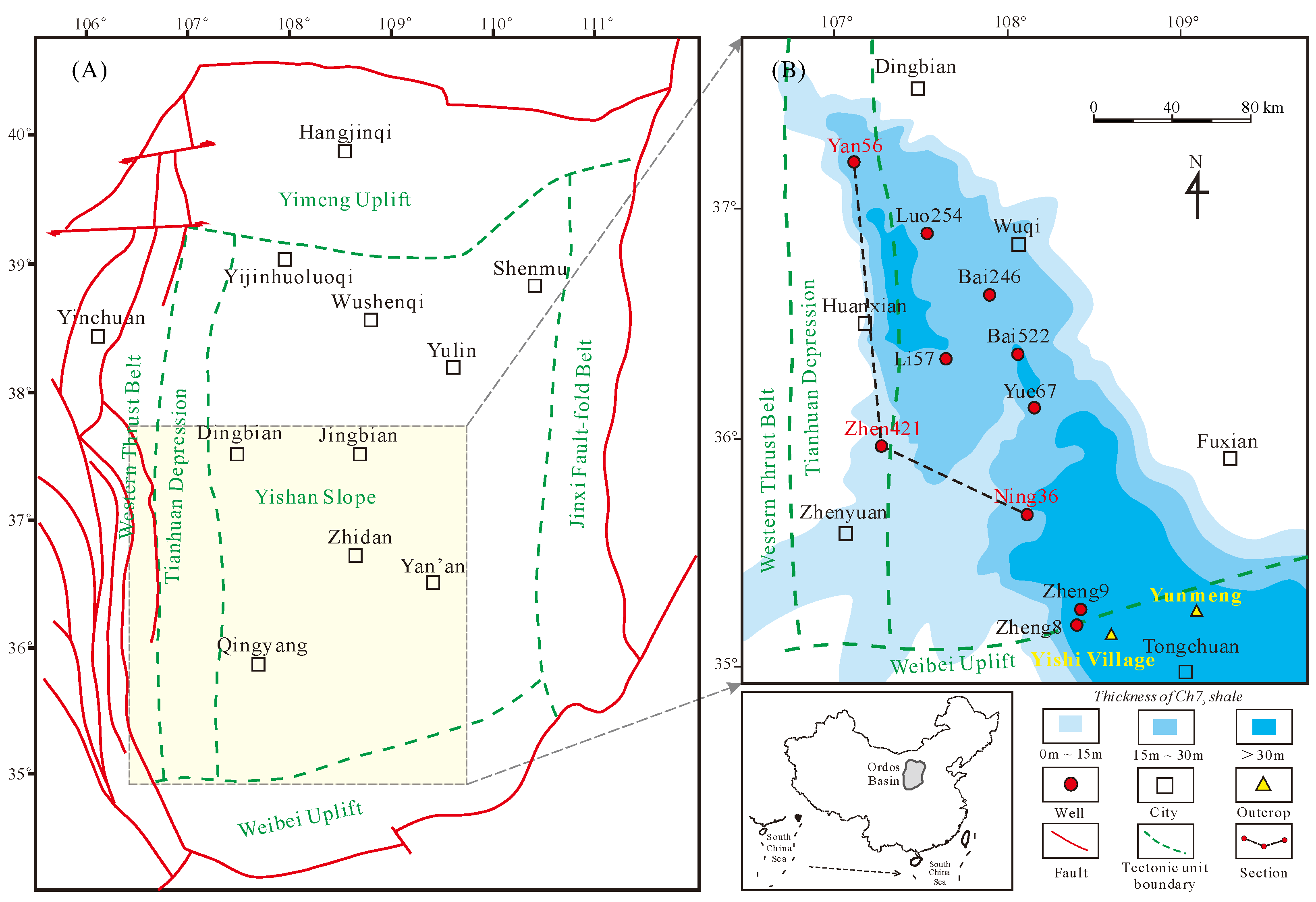
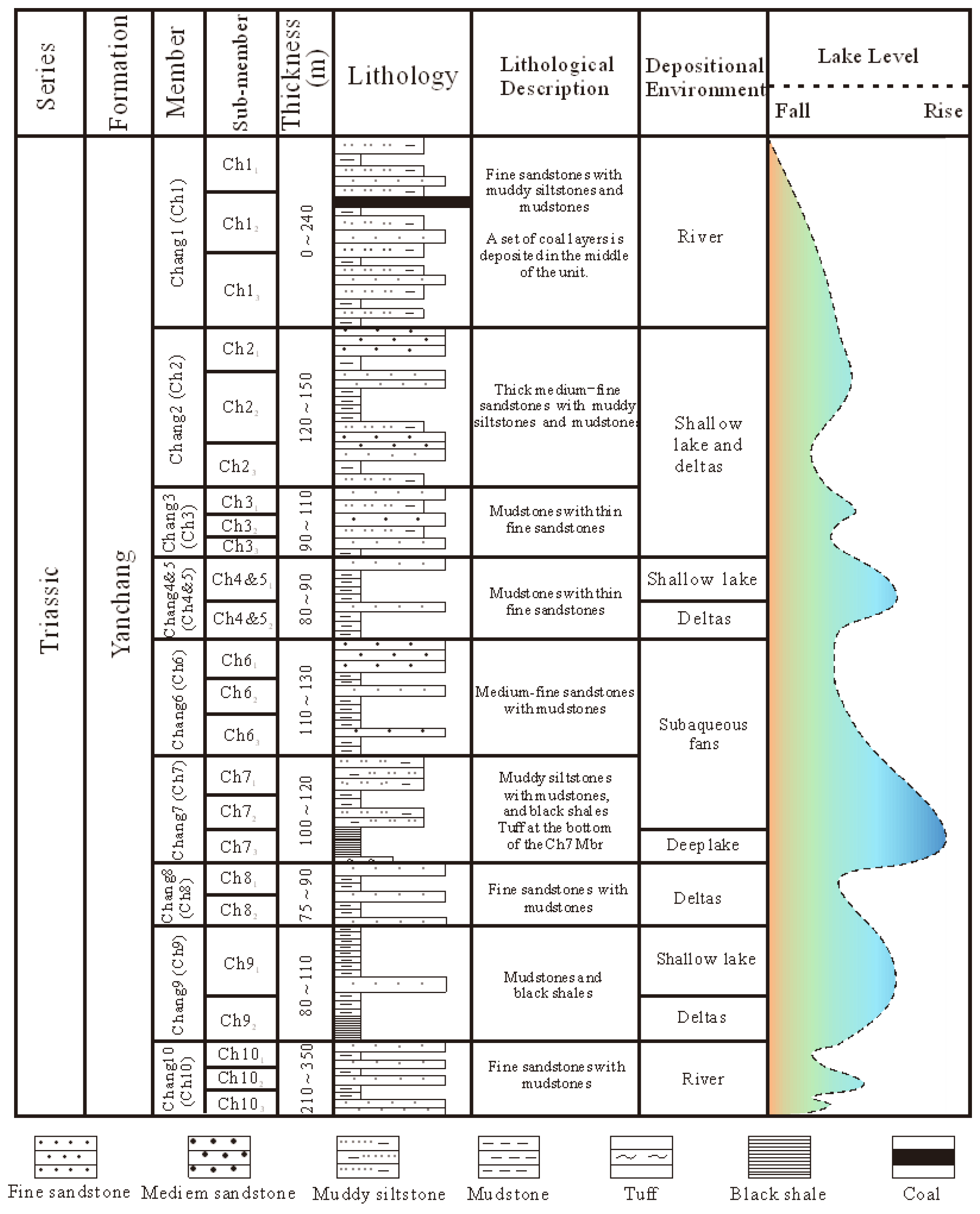

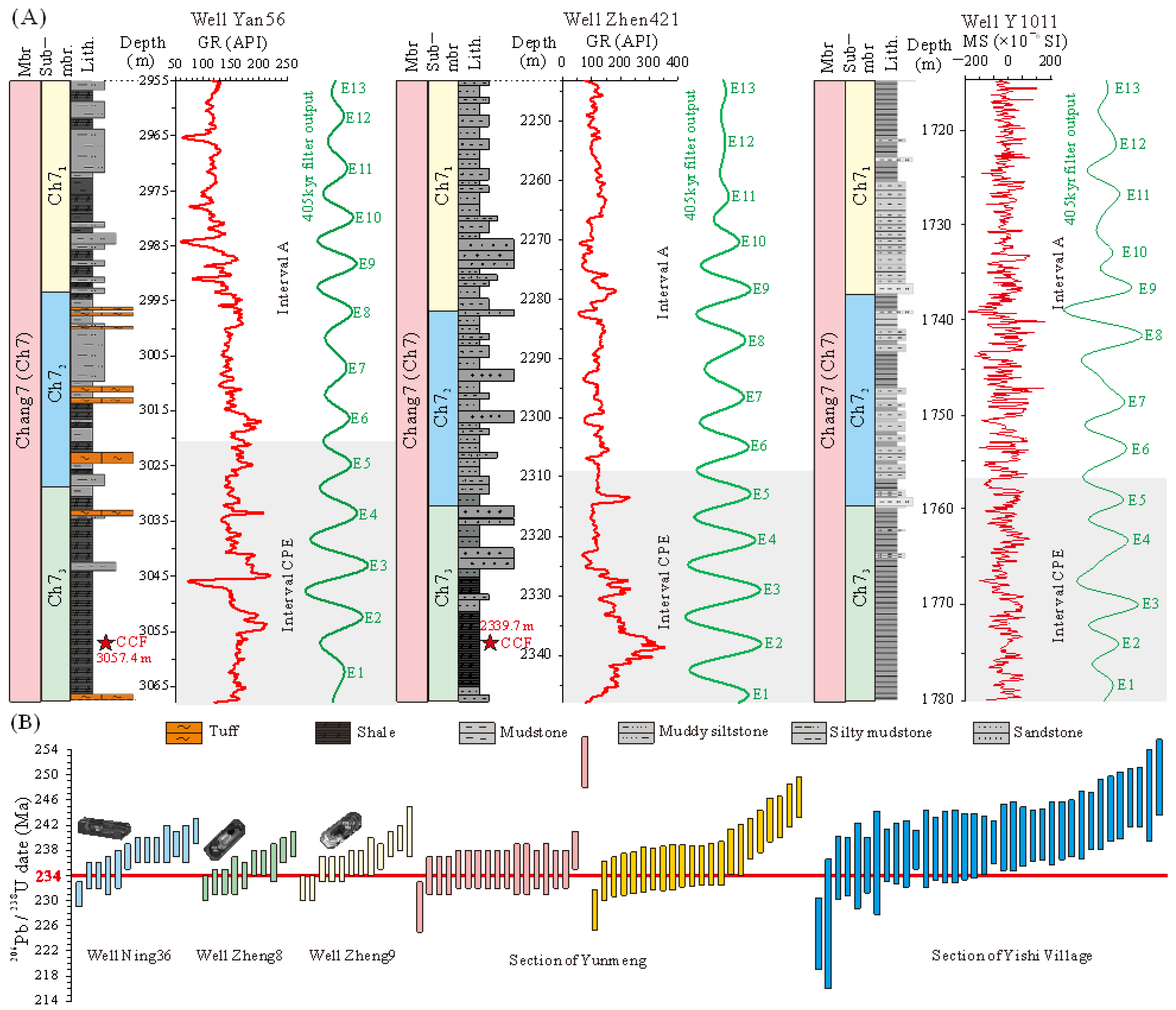

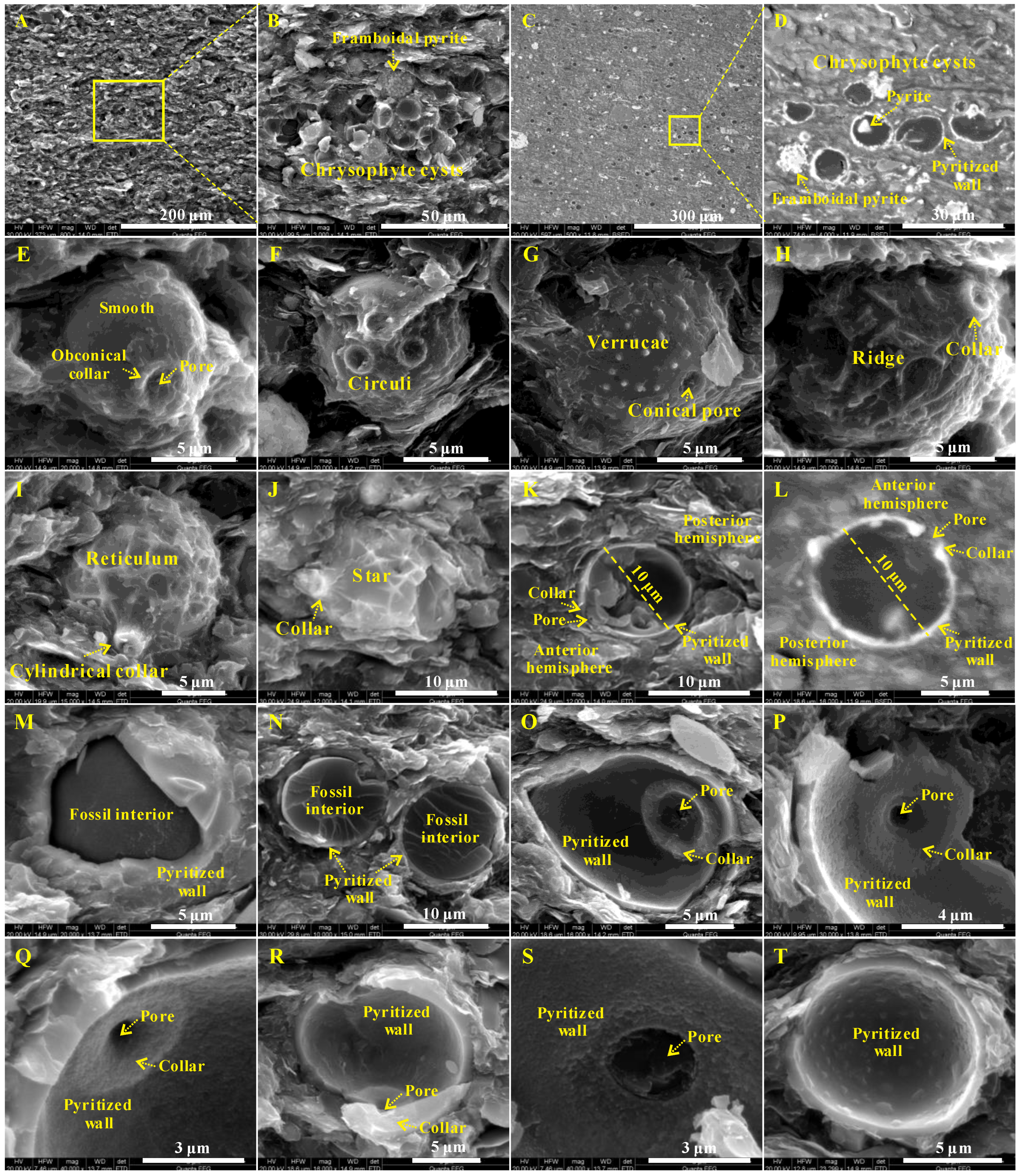

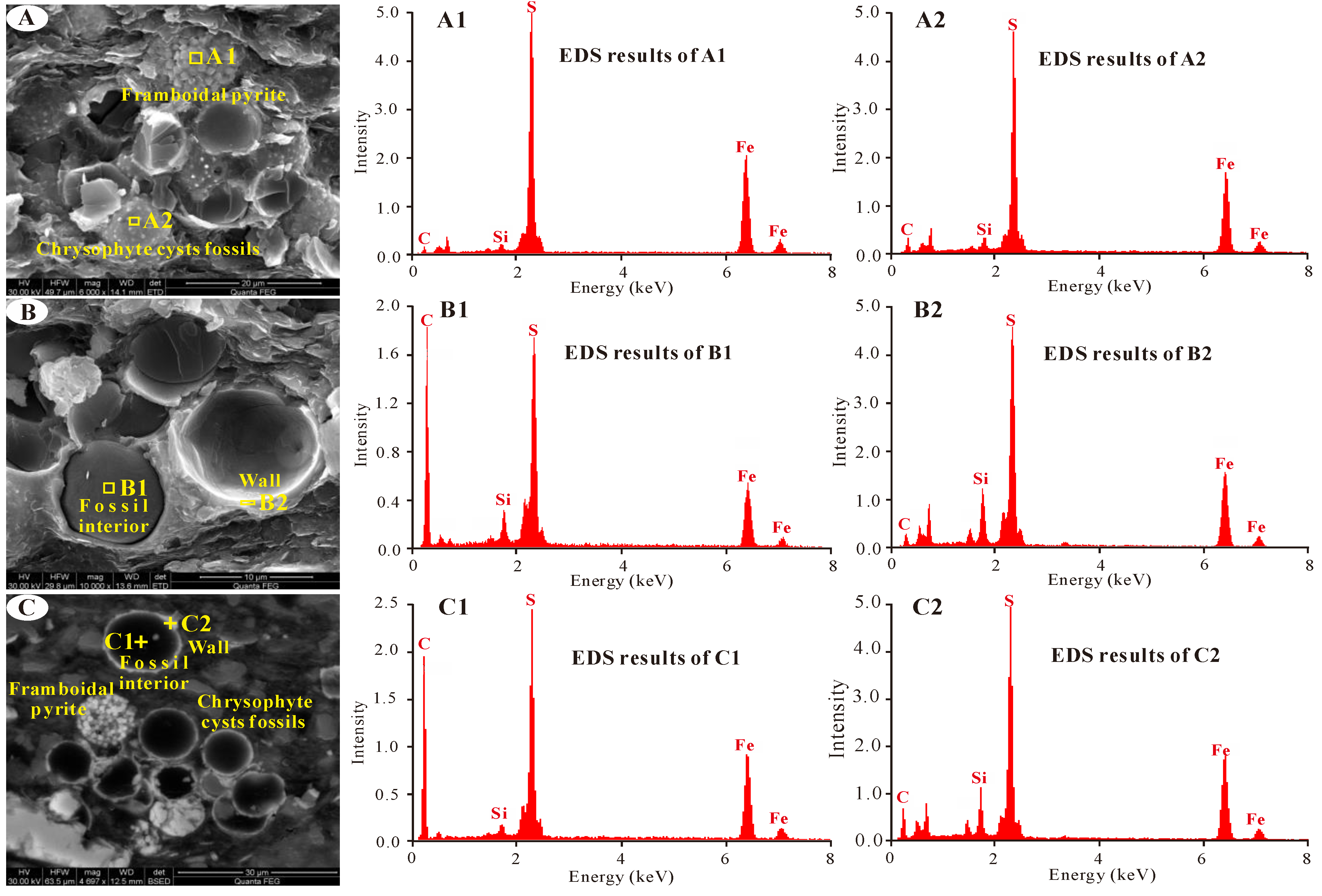
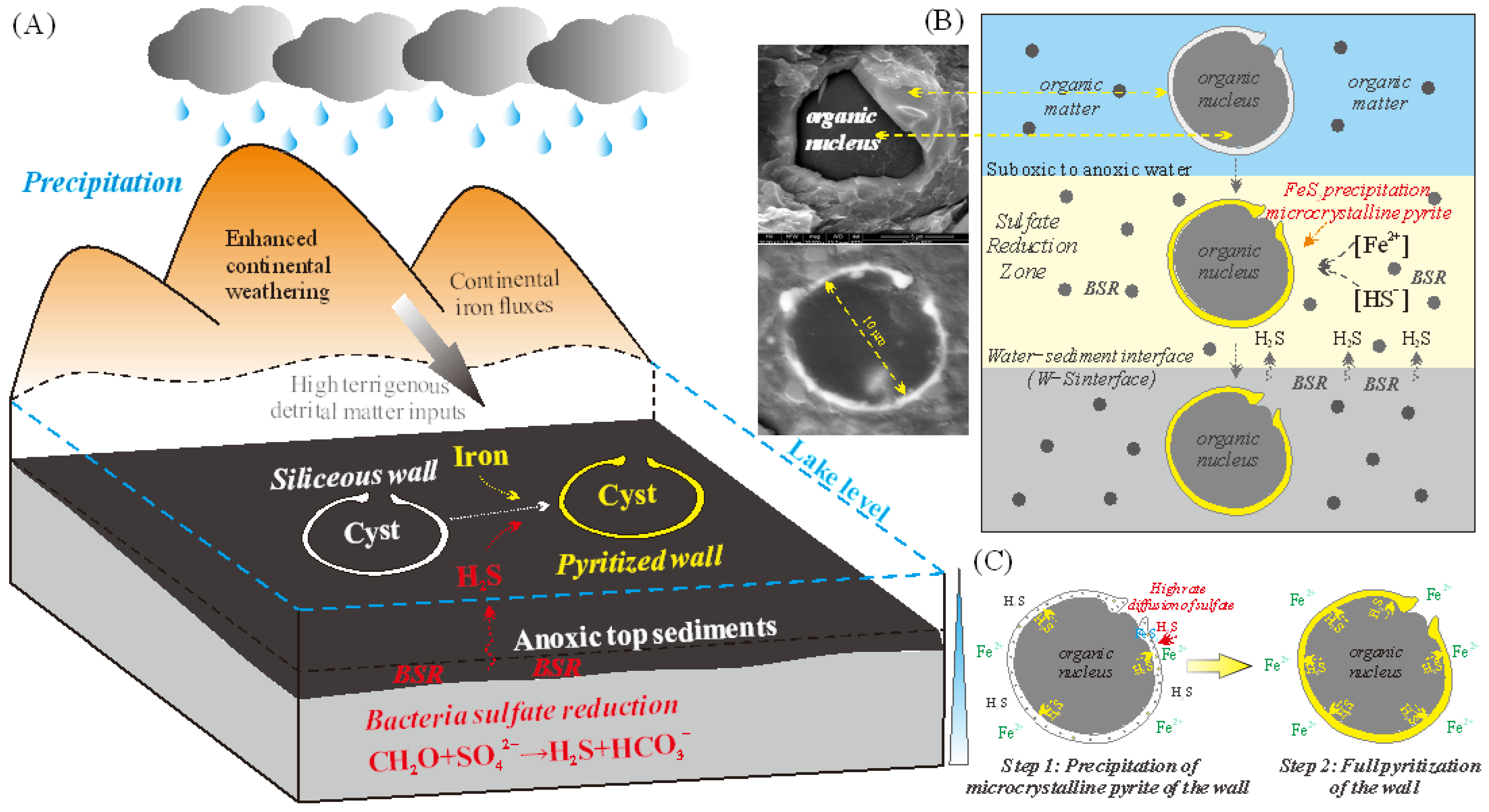
Disclaimer/Publisher’s Note: The statements, opinions and data contained in all publications are solely those of the individual author(s) and contributor(s) and not of MDPI and/or the editor(s). MDPI and/or the editor(s) disclaim responsibility for any injury to people or property resulting from any ideas, methods, instructions or products referred to in the content. |
© 2023 by the authors. Licensee MDPI, Basel, Switzerland. This article is an open access article distributed under the terms and conditions of the Creative Commons Attribution (CC BY) license (https://creativecommons.org/licenses/by/4.0/).
Share and Cite
Cao, J.; Gang, W.; Yang, S. Pyritization and Preservation Model of Chrysophyte Cyst Fossils in Shales during the Triassic Carnian Pluvial Episode, Ordos Basin, China: Evidence from Cyclostratigraphy, Radiometric Dating and Geochemical Analyses. Minerals 2023, 13, 991. https://doi.org/10.3390/min13080991
Cao J, Gang W, Yang S. Pyritization and Preservation Model of Chrysophyte Cyst Fossils in Shales during the Triassic Carnian Pluvial Episode, Ordos Basin, China: Evidence from Cyclostratigraphy, Radiometric Dating and Geochemical Analyses. Minerals. 2023; 13(8):991. https://doi.org/10.3390/min13080991
Chicago/Turabian StyleCao, Jingjing, Wenzhe Gang, and Shangru Yang. 2023. "Pyritization and Preservation Model of Chrysophyte Cyst Fossils in Shales during the Triassic Carnian Pluvial Episode, Ordos Basin, China: Evidence from Cyclostratigraphy, Radiometric Dating and Geochemical Analyses" Minerals 13, no. 8: 991. https://doi.org/10.3390/min13080991
APA StyleCao, J., Gang, W., & Yang, S. (2023). Pyritization and Preservation Model of Chrysophyte Cyst Fossils in Shales during the Triassic Carnian Pluvial Episode, Ordos Basin, China: Evidence from Cyclostratigraphy, Radiometric Dating and Geochemical Analyses. Minerals, 13(8), 991. https://doi.org/10.3390/min13080991




